In our last few blog posts, we’ve talked about customer segmentation and different ways to segment your target audience into smaller chunks like demographic and psychographic segmentation to connect with the right people. Customer segmentation enables marketers to focus their marketing efforts on their target customers, improving their marketing targeting strategy.
But what if there was a subset of users that had an even bigger impact when targeted? Enter Super Users – the strategic players who can give your ROI numbers a major boost! It may take some trial-and-error testing to pinpoint these super segments accurately, but knowing how these key individuals interact is essential for any successful marketing targeting strategy.
What is a Super User?
As technology progresses and media consumption grows, a unique group is rising to the top.
Activate Consulting’s Technology & Media Outlook 2023 found that Super Users are powering the digital world, with a strong presence across all major media and technology verticals. This select crowd is made up of young, educated individuals who lead affluent lifestyles – spending more time and money than any other user group!
Why should you add Super Users to your marketing targeting strategy?
Super Users are a highly influential audience with the potential to drive major business growth. They stand out from other users in their commitment and dedication across four key areas:
- Time spent with media
- Spend
- Technology and media adoption
- Emerging eCommerce behaviors
“Over the next years, the imperative for technology and media companies will be to identify, reach, and super-serve Super Users – the single group of power users whose time and spend far surpass those of other users.”
Activate consulting’s technology & media outlook 2023
You can use Super Users as a subset of your marketing targeting strategy. While you may need to reach beyond Super Users to achieve your goals, it’s worthwhile to consider:
- Targeting them separately
- Spending more on media
- Reaching them at a higher frequency
Time spent with media
Super Users make a powerful impact, despite comprising only 22% of the U.S. population. They are incredibly influential in terms of media consumption and engagement – spending more than double the amount of time interacting with content compared to other users.
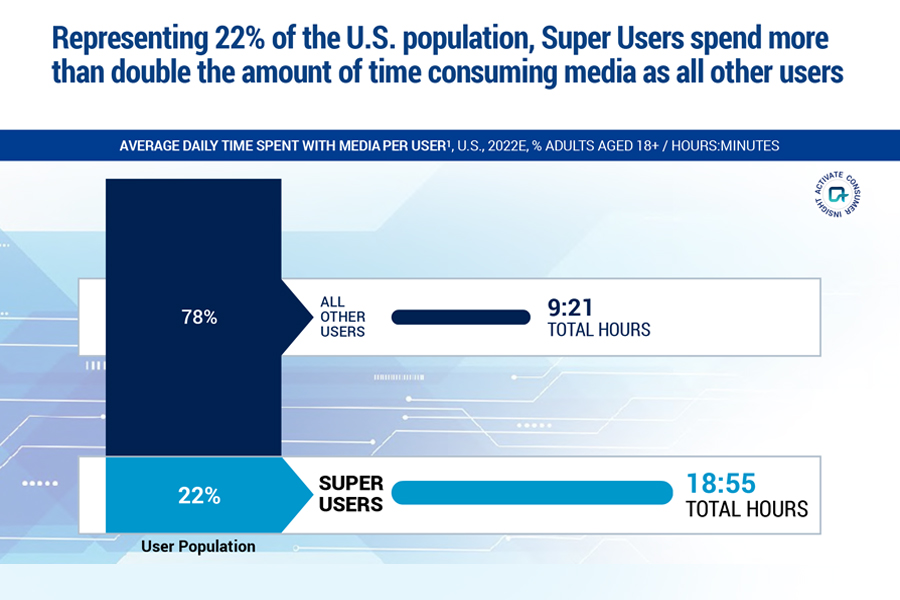
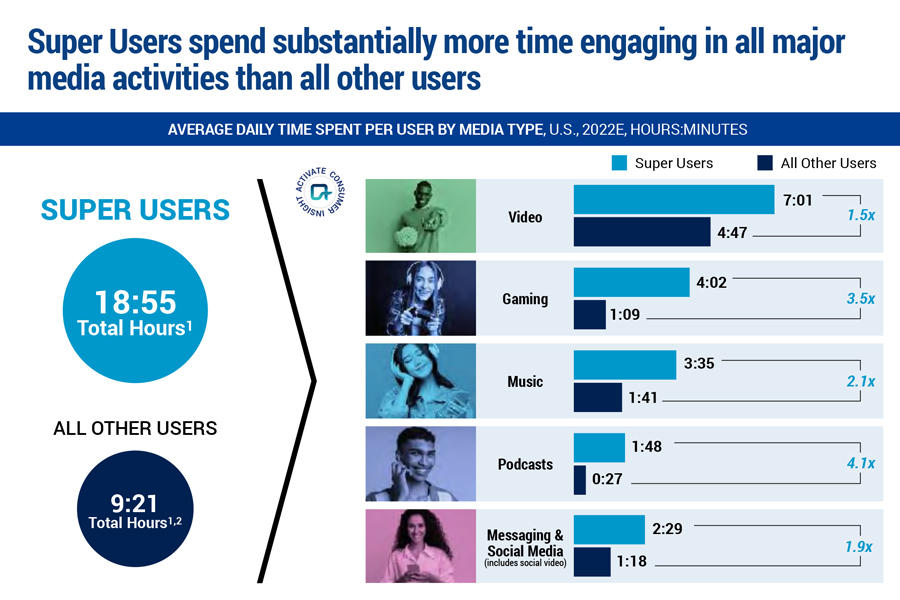
Inclined to multitask
Super Users take multitasking to the next level. Not only do they spend more time with electronics, but they excel in the art of juggling multiple activities. While watching videos and playing video games on one device, Super Users might also be busy engaging with social media on another. This makes them an unstoppable force when it comes to getting the most out of their digital experiences!

High share of dollar spend
Super Users are big spenders when it comes to media, particularly in gaming and music. Compared with all other users, Super Users’ average video spend is close to triple the amount ($76 vs $27). However, their biggest increases come from gaming and music; they’re collectively spending 12x more on games and shelling out 21x as much for tunes!
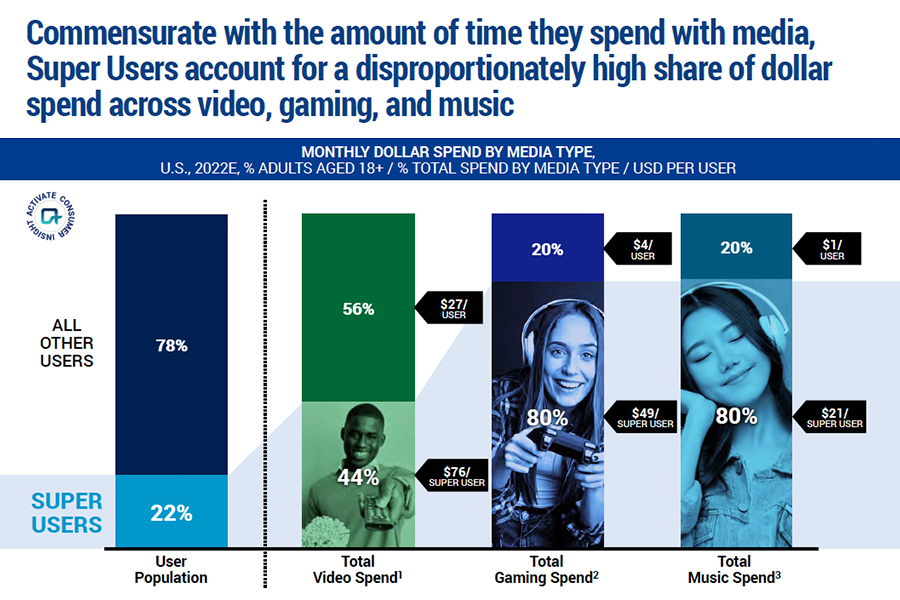
With 60% of eCommerce spend coming from Super Users, they are driving the industry forward with their enthusiasm and willingness to test out cutting-edge shopping trends like buying through social media, live streaming purchases, and trying on products virtually. Super Users are setting the tone for this dynamic industry.
Technology and media adoption
Most Super Users are brand advocates. They’re trendsetting individuals who stay ahead of the curve on media and technology. They eagerly take advantage of new products, services, and data-sharing opportunities to receive tailored ads that fit their lifestyle.
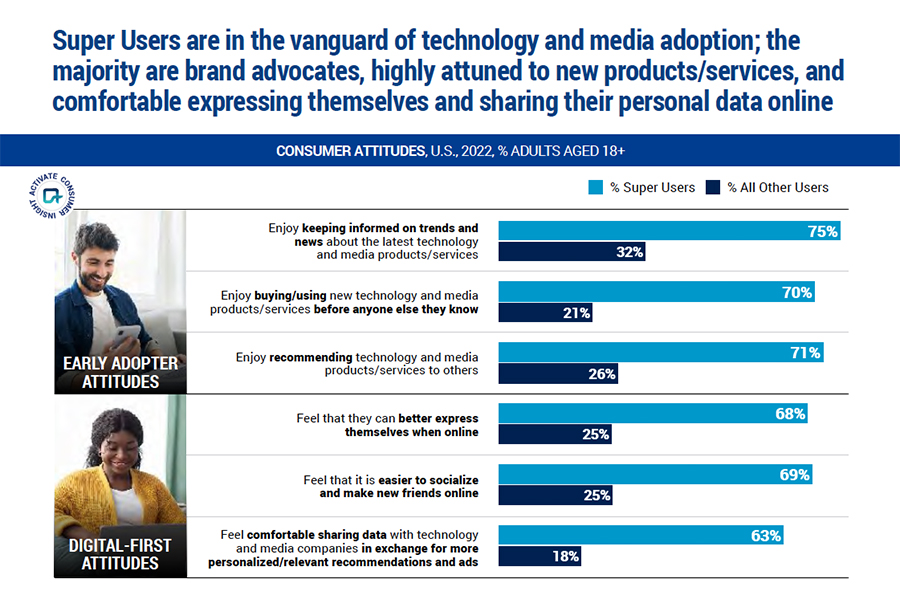
Crypto & NFTs
Super Users blaze the trail for cryptocurrency and non-fungible tokens (NFTs)! This group is five times more likely to explore, engage with, and embrace new digital-monetary technologies.
Pioneers of the Metaverse
As Metaverse usage continues to rise, Super Users are leading the way. Over 80% of these trailblazers have embraced these digital spaces within just the last year. We’re seeing accelerated interest from them as they seek out new opportunities for creativity, connections, and transactions within their favorite Metaverses. Many express interest in Metaverse experiences such as purchasing physical items to creating virtual havens. In fact, they’re 5x more interested in all things meta-related!
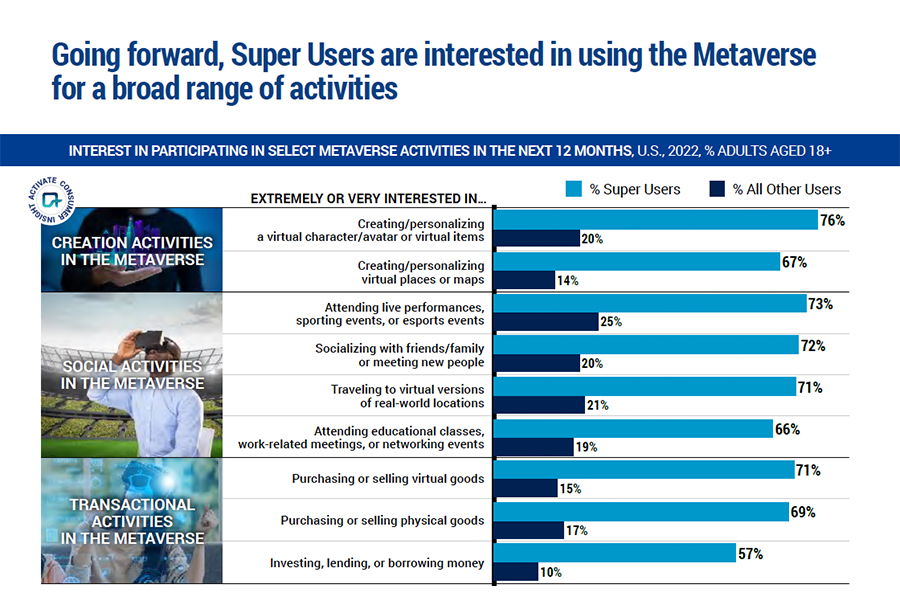
How Experian can help you identify and target Super Users
So how can you find your Super Users and include them in your marketing targeting strategy? Whether you want to build or acquire highly addressable audiences, we can help you precisely reach the right individuals and households in any channel you desire with Consumer View.
Consumer View
It all starts with data. Delivering the right message in the right place at the right time means truly knowing your prospects and customers as individuals – their lifestyles, behaviors, and shopping preferences. Consumer View data can provide a deeper understanding of your customers.
Consumer View is the world’s largest consumer database that contains over 3,900 attributes for 250 million adult consumers in the U.S. with coverage of 126 million (98%) of U.S. households. Consumer View can help you find out:
- What do your customers look like?
- What do your customers do?
- How and when should you reach your customers?
- What motivates your customers?
Modeled and syndicated audiences
We have over 2,500 pre-built audiences that are privacy-safe and built using advanced data science and the most comprehensive consumer data available. These digital audiences are readily available via major publishers, data management platforms (DMPs), advanced TV operators, and demand-side platforms (DSPs).
Our pre-built audiences can be used consistently across multiple distribution partners – making sure you can quickly find the right audience for the right campaign without having to build your own consumer personas. In addition to being available as digital audiences, our segmentation products are also available to use across all consumer touchpoints to enable consistent omnichannel campaign targeting.
There are infinite data combinations and selections we can help you with for optimal audience targeting. Using our comprehensive inventory of data, we can find even the most unusual of audiences to help you connect with new prospects. From demographics to behavioral and psychographic information, we draw on a massive base of knowledge accumulated during five decades in business.
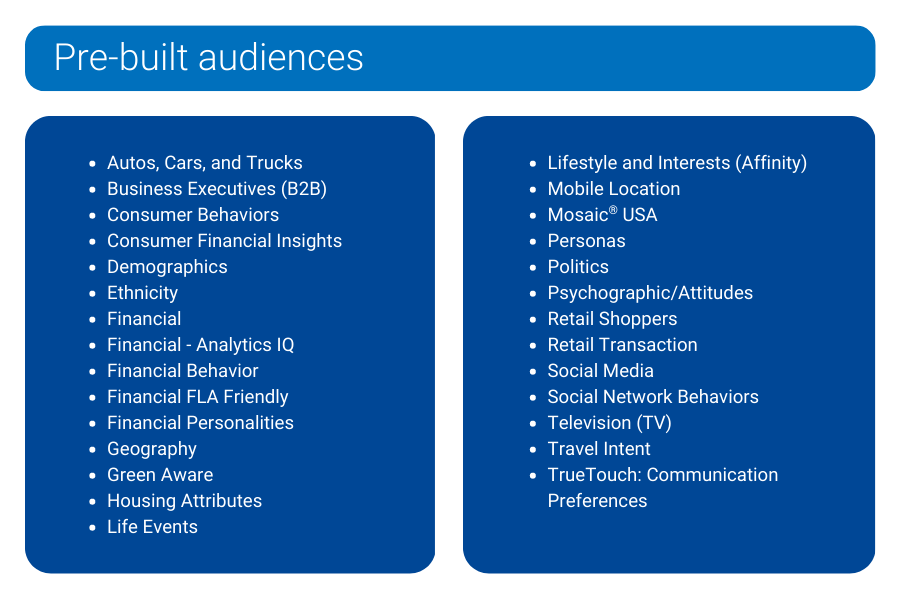
Mosaic® USA
Experian’s Mosaic® USA is a household-based consumer lifestyle segmentation system that classifies all U.S. households and neighborhoods into 71 unique types and 19 overarching groups, providing a 360-degree view of consumers’ choices, preferences, and habits. Using Mosaic lifestyle segmentation, you can anticipate the behavior, attitudes, and preferences of your best customers and reach them in the most effective traditional and digital channels with the right message in the right place at the right time.
Tailored Segmentation uses a sophisticated data-driven clustering system that leverages the 71 Mosaic types that match to first-party data like yours. Tailored Segmentation allows you to regroup Mosaic types based on the attributes you weigh as more impactful to your business. Have you designed your own segments in-house? You can apply Tailored Segmentation to those segments for deeper insights through a tailored analysis. Are you still looking for a way to segment your market even though you understand your typical best customer? Tailored Segmentation can weigh these attributes and develop a custom clustering and analysis of your market.
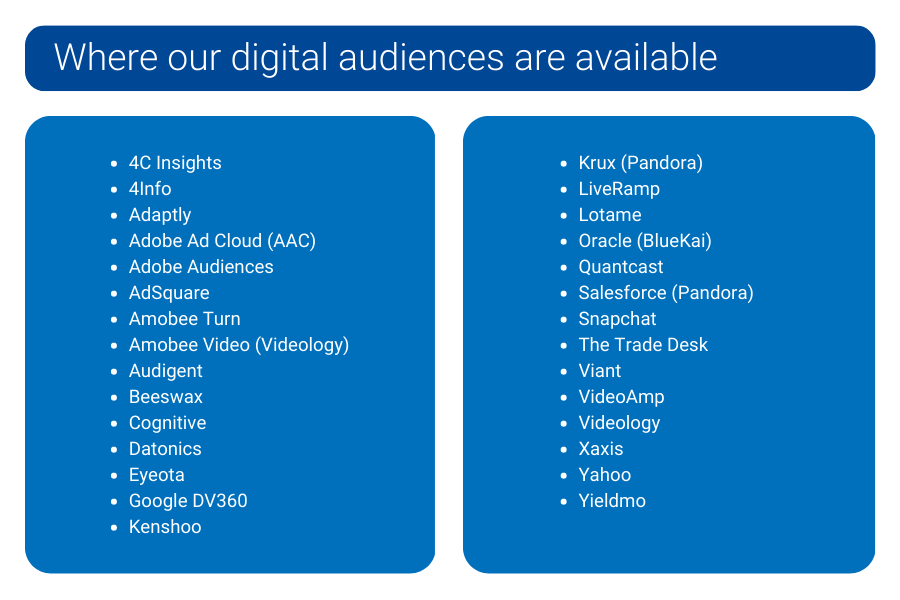
We can help you find your Super Users
Super Users are an important segment of any market. Marketers need to be able to identify them quickly and act upon their insights. Our marketing solutions provide the necessary data and analytical capabilities to easily find and target your potential Super Users for an effective marketing targeting strategy.
With Experian, you can deliver messages that are more in line with what matters to this influential group of customers. We understand how challenging it can be to find these customers and ensure they get the tailored, personalized messaging they deserve – so let us help you do just that! We can provide deep insights beyond the generic customer persona that allows marketers to look into the effectiveness of their marketing strategies from multiple angles. We want to help you gain an edge over your competitors by helping you identify, target, and engage Super Users for increased revenue growth. Ready to find your Super Users?
Sources
Activate Technology & Media Outlook 2023. Activate Consulting.
Latest posts

As I walked onto the buzzing streets of Cannes for the first time, my senses were immediately captivated by the energy that filled the air. I'd heard plenty about Cannes Lions, the globally revered International Festival of Creativity, but being in the midst of it all was an entirely different ballgame. 1. A visual extravaganza From the moment I woke up from my two-hour nap, (Seattle was a long way to travel to Cannes), I was awestruck by the grandeur of the festival. Usually known for its tranquil beauty, the city was alive and brimming with imagination. Massive installations, eye-catching billboards, and immersive media experiences were scattered over the two-kilometer stretch of La Croisette, transforming the city into a canvas of creativity. I saw firsthand how abstract concepts could be turned into palpable realities, especially those of Spotify, Yahoo!, and Stagwell's Sport Beach with their basketball court with stadium seating setup. 2. Nuggets of wisdom shared in panels The festival's days were jam-packed with thought leadership panels – each a masterclass in the ever-evolving universe of AdTech. Fortunately, as a member of the Experian team, I didn't have to travel far for unique panels; we hosted four panels throughout the week, and I was immersed in dynamic discussions about new trends, groundbreaking ideas, and the challenges ahead. One recurring theme that resonated with me was the intricacies of authentically connecting with consumers. Finding genuine human connections amidst digital chaos can be challenging in today's tech-driven world. These dialogues provided incredible insights into how we could maintain the delicate balance between personalization and privacy and effectively use artificial intelligence (AI) to enhance customer engagement without compromising the human essence in advertising. Watch our panels 3. Connect with your peers If Cannes Lions is known for anything apart from its creative inspiration, it's the unparalleled networking opportunities. The festival allowed me to interact with professionals from all corners of the world. Each exchange was not merely about exchanging contact details but building meaningful relationships. Will these first arcs lead to meaningful friendships? I sure hope so. 4. A comprehensive learning opportunity The most crucial aspect of the festival was the immense opportunity it offered for learning. I found myself constantly absorbing new information and insights from the panels, every conversation, and every chance meeting. 5. Juggle your time Effective time management was crucial for maximizing my Cannes experience, with many things happening concurrently. I would give myself a B- for this. During the day, when I had some downtime, I could have ventured to another panel, attended a networking event, or taken in a view of the city I didn't get. That's the biggest challenge, and the beauty of Cannes Lions is its unique blend of professional learning opportunities set against the backdrop of a picturesque seaside town, but how do you do it all? 6. Relish the experience My week at Cannes was filled with intense learning, insightful conversations, and eye-opening experiences, leaving me mentally drained and intellectually stimulated (I think those can happen concurrently). The festival left me with a renewed appreciation of why we do what we do in the AdTech industry: supporting the pursuit of creativity, the drive for innovation, and the desire to forge meaningful connections. Cannes Lions was more than just a festival – it was a week of stepping out of my comfort zone, gaining deep insights, and establishing relationships that I hope will last a lifetime. As I boarded my flight out of Nice, surrounded by adults with layers of event access bracelets, I was inspired and stacked with knowledge and ideas that will help drive meaningful marketing opportunities with our content and partnerships. The grandeur, the learning sessions, the networking, and the profound lessons exceeded all my expectations. My week at Cannes Lions was unique, intense, insightful, and unforgettable. It was an experience I can't wait to repeat! Follow us on LinkedIn or sign up for our email newsletter for more informative content on the latest industry insights and data-driven marketing. Latest posts

It’s been one week since the highly anticipated Cannes Lions 2023 – the event of the year for advertising and creativity. We're thrilled to share our top four key takeaways from the event, showcasing what the industry will prioritize in the upcoming year. Signal loss At Cannes Lions 2023, experts underlined the detrimental effects of signal loss on advertising and emphasized the significance of having diverse channels. Discussions emphasized the importance of adapting paid media strategies to align with evolving consumer behaviors in order to remain relevant in the ever-changing landscape. Urgency in planning and avoiding being caught without a solid strategy was a common theme throughout the event. Alternative identifiers, like first-party data, were highlighted, as they prioritize privacy-centric approaches. Contextual advertising emerged as a key part of the solution, providing relevant ads that fit seamlessly into the user's experience. Collaboration Collaboration was a major theme at Cannes Lions 2023. Attendees explored topics such as maintaining privacy and identifying the right attributes for effective targeting. Clean rooms were discussed as a way to ensure privacy when sharing data, and highlighted partnerships as the key to unlocking interoperability within the advertising ecosystem. The discussions underscored the need for industry players to join forces and collaborate on solutions that benefit all stakeholders in the ecosystem. “What makes Cannes unique is that you have a lot of decision makers in the room at the same time. This leads to more efficiency in terms of coming up with goals and objectives and really getting to the heart of the key aspects for us to build partnerships.”alison omealia, vp, customer success, experian Personalization Personalization was a key topic of discussion at Cannes Lions 2023, with its growing significance in advertising taking center stage. The event emphasized the need to focus on serving up tailored content that resonates with individual consumers, cultivating brand affinity. The intersection of science and art was highlighted, emphasizing the role of data-driven insights and creativity in supporting frequency capping and delivering engaging content. Advertisers are adapting to cookie deprecation by shifting from cookie-based third-party targeting to first-party data solutions. This is due to the significant changes in the consumer privacy landscape, which have limited advertisers' access to signals emitted by consumers through their devices and browsers. As a result, alternative IDs like UID2, Ramp ID, and ID5 are emerging as viable options for advertisers to continue personalized targeting. Balancing AI and creativity at Cannes Lions 2023 Participants shared invaluable insights on how to strike the right balance between harnessing AI's capabilities and nurturing creativity to keep the human touch alive. The event emphasized the importance of understanding the boundaries of AI while utilizing tools that drive innovation and imagination. Attendees explored the dynamic roles that AI provides and discussed how it can help push the boundaries of their creativity while still keeping the human element intact. As technology continues to advance, so does the need for advertisers to adapt their approach and integrate AI in a way that enhances their creative output. Experian events at Cannes Lions 2023 We hosted a series of events that included a kick-off event and four panels. The activities were designed to provide attendees with valuable insights on various topics related to advertising and data privacy. Here's a recap of what we covered during the week. Experian’s Cannes Lions kick-off event We co-hosted a kick-off event on Sunday with Audigent. It was a successful event that brought people together to launch an important week in the AdTech industry and build connections with clients and prospects alike. Data on the sell-side Ongoing signal loss has marketers, agencies, and platforms tapping directly into the sell-side for high-quality audience and context. In this panel, industry experts from Truthset, Captify, Audigent, Newsweek, and PubMatic joined Experian to discuss the imminent disappearance of cookies and the need to adapt and future-proof data privacy strategies. The deprecation of third-party cookies presents an incredible opportunity to redefine data privacy practices and empower consumers. Our panelists emphasized the need to adapt and invest in alternative identifiers in order to thrive in a cookie-less future. Publishers were urged to create valuable content, engage in first-party activities, and consider the next generation of consumers who are growing up without traditional identifiers. The fragmented landscape calls for a variety of tactics and partnerships, while AI can provide opportunities to explore beyond deterministic identifiers, fostering creativity and innovation in advertising practices. Stacking the marketer's toolbox for success In partnership with Adweek Abroad in Cannes, industry leaders from FreeWheel, Tubi, and Instacart joined Experian to discuss opportunities for brands to unlock deeper, richer, and more scalable insights into current and potential customers. The panelists highlighted several key considerations, including building a robust first-party data strategy, ensuring accuracy in data quality partnerships, and establishing better-connected communications and relationships with consumers. Participants acknowledged the value of consumer data and urged advertisers to remain purpose-driven, always putting the viewer first. The freshness and recency of data were identified as critical factors for establishing quality connections with consumers and staying attuned to consumer trends. What does the future of identity hold? During this panel discussion, industry leaders from the IAB, MiQ, Cint, Direct Digital Holdings, and Tatari joined Experian to explore the future of identity. The panelists discussed the challenges cookie deprecation poses in programmatic advertising and the need for new identifiers and solutions. They also acknowledged the expanding media landscape and the importance of frequency capping and attribution measurement in a post-cookie era. Trends to watch for include the potential consolidation of identifiers and the movement of first-party data in-house by larger media companies. Panelists shared different views on cookie deprecation readiness and the overhype of AI in the industry. Streaming takes center stage OMG, Roku, AMC Networks, Paramount, and Disney joined Experian to discuss streaming TV as a fragmented and evolving landscape. The panelists debated whether it has become a performance channel and emphasized the need for client education, attribution, and optimizing performance metrics. They also discussed reaching audiences across different mediums with data interoperability, audience targeting, and reliable identity solutions. The panelists explored the emerging trend of AI, optimizing ad placement, refining targeting, streamlining creative approval, and enhancing ad breaks. “A lot of trends in AdTech are relevant to TV, but the most consistent trend has definitely been having a solid identity source throughout the whole lifecycle of a campaign within TV.”ali mack, sr. director, platforms, experian Watch our panels Let’s keep the conversation going The innovation and possibilities for signal loss, collaboration, personalization, and balancing AI and creativity are limitless, but understanding exactly how to get there is what can make all the difference. As we wrap up another successful week at Cannes Lions, let's use these conversations as an opportunity to advance together toward a more connected future — what trends are you most looking forward to? If you’d like to discuss any of these topics further, get in touch with us! Contact us Check out more Cannes content: Insights from a first-time attendee Four new marketing strategies for 2023 Exploring the opportunities in streaming TV advertising The future of identity in cookieless advertising Maximize ad targeting with supply-side advertising Follow us on LinkedIn or sign up for our email newsletter for more informative content on the latest industry insights and data-driven marketing. Latest posts

Our next segment in our Ask the Expert series dives into the importance of data enrichment and its benefits across connected TV (CTV) advertising. Ask the Expert features a series of conversations with product experts where we focus on topics that matter the most in AdTech. In our latest segment, Natalia Irmin, Director of Strategic Data & Media Partnerships at a4 Advertising, joins us to chat with Experian's SVP of Sales & Partnerships, Chris Feo. a4 is an advanced advertising and data company that offers audience-based, multiscreen advertising solutions for local and national advertising businesses. In their conversation, Natalia and Chris review: The benefits of data enrichment First-party data enrichment across advertising Data enrichment in CTV advertisingHow Experian and a4 work together What is data enrichment? Data enrichment enhances first-party data sets using third-party data sources. This process involves merging first-party data from internal sources with data gathered from other internal sources or from external third-party sources. Examples of data that can be part of the enrichment process include: Demographic information Contextual signals Behavioral patterns Interests Purchase-intent The more you know about your customers, the better equipped you are to reach them where they are with the right message. By enriching your data, you can enhance your messaging, provide personalized offers, and establish a loyal customer base. First-party data enrichment across advertising Businesses are transitioning from cookie-based third-party targeting to first-party data enrichment solutions as a result of cookie deprecation. When data enrichment is paired with internal first-party data, you can generate a more holistic customer profile. a4 has a rich set of first-party data, based on the subscriptions to their services. a4 uses first-party data enrichment across advertising in two ways: Measure performance using their viewership dataAdvise their customers on where they should focus their advertising efforts based on the customer's viewing behavior a4 supports the enrichment of their customers' first-party data so they can get the most out of their insights. With Experian’s privacy-first approach, a4 can continue to rely on their first-party data while protecting personally identifiable information (PII). Data enrichment in CTV advertising CTV advertising refers to digital advertising that appears through a streaming service during a viewer’s video content, like a movie or TV show. CTV ad campaigns allow businesses to personalize their digital marketing messages while the viewer watches content on various platforms. CTV offers a highly measurable opportunity to increase brand awareness. Benefits of data enrichment in CTV advertising Data enrichment provides three key benefits that can enhance targeting, personalization, and campaign effectiveness in CTV advertising. Understand your target audience By using enriched data such as demographic information, viewing behavior, and interests, you can gain deeper insights into your target audience, refine your targeting strategies, and create highly personalized ad experiences. Data enrichment also enables better measurement and optimization of ad campaigns, maximizing ROI. Integrate enriched data with other marketing channels You can integrate enriched data into CTV with data from other marketing channels. This enables the creation of comprehensive and cohesive marketing strategies that provide consistent messaging and enhance cross-channel targeting. Enhance the value of ad inventory Data enrichment can also benefit content publishers and broadcasters by enhancing the value of ad inventory and providing more targeted and effective advertising opportunities. Enabling your marketers to target specific audiences will result in improved campaign performance. Through data enrichment, you can increase return on your ad spend and boost the value of your publisher’s ad inventory. a4 and Experian can help your business attract additional demand with audience enrichment. a4 uses Experian’s vast offering of audiences and combines it with Experian’s Graph. This data can later be used to activate across a4’s parent company, Altice’s owned and operated properties, as well as beyond Altice’s own footprint via premium publisher partners. How Experian and a4 work together a4 and Experian have a long-standing partnership that enables a4 to enhance its data. Through our Consumer View and Consumer Sync products, a4 can add audience attributes to its subscriber and viewer data to precisely pinpoint the audience that its clients are targeting. Experian helps a4 in building a comprehensive customer profile, which helps expand the customer base for a4's advertising clients. We form partnerships, like we do with Experian, to enhance our data further, so that we can combine the power of the viewership and exposure data for those other attributes that clients might need.” – Natalia Irmin, Director, Data & Strategic Partnerships, a4 Advertising Through Experian's audience attributes and Graph, a4 can assist advertisers in targeting audiences beyond their usual reach, creating a better user experience. a4 can personalize experiences and promotions to prioritize customers with a higher likelihood of making a purchase. By tailoring messages and promotions to individual customer preferences, businesses can improve their advertising efforts and deliver them through their preferred channels. Watch the full Q&A Visit our Ask the Expert content hub to watch Natalia and Chris's full conversation about data enrichment and its benefits across the advertising world. In the Q&A, Natalia and Chris also share their thoughts on the importance of first-party data enrichment, addressability, and measurability in CTV advertising. Watch now About our experts Natalia Irmin, Director, Strategic Data & Media Partnerships, a4 Advertising Natalia Irmin is the Director of Strategic Data & Media Partnerships for a4 Advertising. With over 10 years of experience working with data in the Defense, Finance, and Advertising industries, Natalia currently leads the a4 Strategic Partnerships team in the development of advanced data and media products in support of the organization’s media planning, buying, and advanced analytics business. Natalia holds an MBA from the NYU Stern School of Business and a Bachelor of Arts from Tel Aviv University in Israel. Chris Feo, SVP, Sales & Partnerships, Experian As SVP of Sales & Partnerships, Chris has over a decade of experience across identity, data, and programmatic. Chris joined Experian during the Tapad acquisition in November 2020. He joined Tapad with less than 10 employees and has been part of the executive team through both the Telenor and Experian acquisitions. He’s an active advisor, board member, and investor within the AdTech ecosystem. Outside of work, he’s a die-hard golfer, frequent traveler, and husband to his wife, two dogs, and two goats! Latest posts